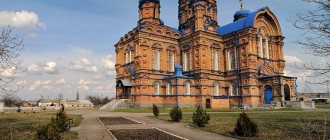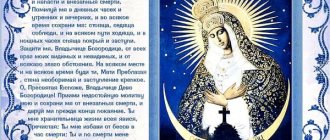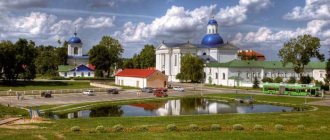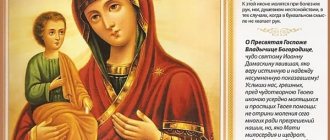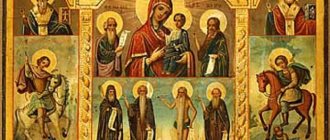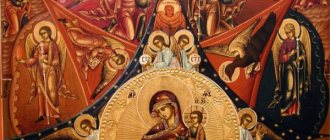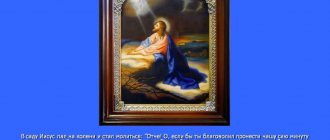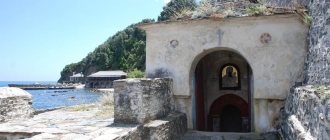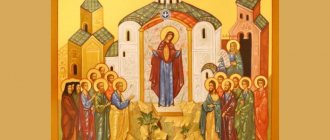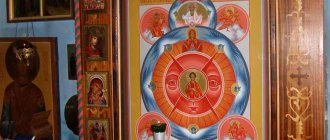The icon of the Mother of God, called Ostrobramskaya, miraculously appeared in the Orthodox world, has been exciting the minds of historians and theologians for several centuries. No one still knows exactly where this shrine came from and who its author is. But, despite this, over several hundred years, the image of the Virgin Mary, revered among both Orthodox and Catholics, continues to acquire legends about great events and miraculous healings that Christian believers owe to the Mother of God, who left her face on oak tablets.
Origin story
There are several versions of the origin of the Ostrobramskaya icon, which no one can confirm. One thing is known for sure: its deposit is considered to be the city of Vilnius in Lithuania, where it is still stored on the Sharp Gate (Bramakh), which is how it got its name.
Major versions
The first version of the appearance of the Ostrobramskaya or Vilna (as the Lithuanians call it) Mother of God on the gates of the city says that on April 14, 1461, the icon, by the will of God, ended up on the Ostrobrama. But historians who do not believe in such miracles claim that the icon was brought by the Lithuanian prince Olgerd in the 15th century from the Crimea, more precisely from Korsun (modern Chersonese) as a trophy after the successful conquest of the Crimean Tatar peninsula. His wife, Juliana, transferred the shrine to the Holy Trinity Monastery, where it remained for a long time.
Union
Despite the fact that the icon initially fell into the hands of a Catholic prince, it was the Orthodox Christians who lived in the Sharp or Russian End, where the Holy Trinity Church and the monastery stood, who took care of it. But in 1596, the Union of Brest (Church) was signed, which meant that from now on the Orthodox Church would come under the leadership of the Pope and the Western (Roman Catholic) Church. Subsequently, the icon, along with all the Orthodox shrines of those years, passed to the Catholics, and then to the Carmelite monks, who saved it from the fire.
Reverence
When the icon fell into the hands of the Carmelites, they were so inspired by its image that they built a separate chapel for it and held forty-hour services in its honor. Local parishioners donated valuable items to restore the wooden church that burned down in 1714, in which the icon was kept. In its place, a new stone church was built, connected to the Holy Trinity Church.
Chapel
At the time when the icon belonged to the Carmelite monks, in 1671 they built a small chapel over the Ostra Brama. A staircase leads to the chapel from the covered gallery. Thus, to enter the city, you must pass under the Ostrobramskaya icon. In the 19th century, an unspoken rule was established among local residents that everyone who passes under the image of the Virgin Mary must remove their headdress.
Since the beginning of the 18th century, people have hung various gold and silver jewelry, shoulder straps, images of hands, feet and cars on the walls of the chapel as a sign of various vows and requests that they make to the Blessed Virgin Mary.
Coronation of the image of the Blessed Virgin Mary
The coronation took place on July 2, 1927, on the initiative of Pope Pius XI. During the celebration, which took place in Vilnius, local residents and pilgrims brought many gifts in the form of jewelry, decorating the walls of the chapel. On the same day, the Ostrobramskaya icon was decorated with gold crowns, which subsequently disappeared. They were replaced with ancient crowns - silver and copper, gilded, but in 2021 the image was again decorated with gold.
Icon of the coronation of the Virgin Mary when it helps. Coronation of the Blessed Virgin Mary. Icon on canvas
CORONATION OF THE MOTHER OF GOD
In the center of the icon is a kneeling Virgin Mary. She stands on the clouds, leaning on the crescent moon - the symbol of the Church, dressed in a tunic and maforium with a white scarf on her head, folding her hands on her chest in a gesture of heartfelt prayer. To the right and left of Her are Jesus Christ in red with a cross and the Lord of Hosts, leaning on a sphere symbolizing the universe. They place a golden crown on the head of the Virgin Mary, as a symbol of the Queen of Heaven. The Holy Spirit in the form of a dove hovers above Them. The icon was made by a good craftsman on a linden board, fastened with two mortise dowels, using the technique of oil painting in the Ukrainian Baroque style. The composition is built vertically. The figures are in active movement. The fields are decorated with gilded rocaille designs and flowers. The lush folds of the clothes are painted in sintered silver. The plot of the icon is directly related to the feast of the Dormition of the Blessed Virgin Mary, which in honor and memory of Her has been established by the Church on August 15 since ancient times. This is a great, twelfth and universal holiday, for on this day.
This composition appeared in Russian icon painting at the end of the 17th century. The samples were engraved illustrations of old printed liturgical books from Ukrainian editions, such as: Ioanikia Galatovsky 1659 (Kyiv), 1682 (Lviv, first edition 1668), , 1682 (Chernigov), and many others. Such icons were most common in Ukraine in the 18th and early 19th centuries. One of the earliest on Russian soil can be considered in the middle of the icon of 1694 by Kirill Ulanov from the Church of the Intercession in Fili (Moscow). At a later time it appears as an independent composition. In the Western tradition, the oldest images of this subject date back to the end of the 13th century. and are often included in altar compositions and carved decoration of temple facades, or are part of the composition, since it is believed that the Coronation took place in heaven immediately after the Assumption. In the Western Catholic Church there is a rite of crowning by the Pope of the most revered miraculous icons of the Mother of God.
The iconography of the Coronation of the Mother of God developed in the art of Catholic Europe in the 13th century.
In Russian art, images of the Coronation of the Mother of God appeared in the last quarter of the 17th century.
The published icon depicts the Holy Trinity - God the Father, God the Son and God the Holy Spirit in the form of a dove. The Mother of God kneels before the Father and the Son, who place a royal crown on her. Thus, the Mother of God is glorified as the Queen of Heaven. Below her feet is a crescent moon. This detail corresponds to the image from the Apocalypse:
The Mother of God is revered in Orthodox Christianity, and her icons occupy a special place not only in churches and temples, but also in the souls of people. Images of the Mother of God often become a source of healing and wisdom for those who turn to them with righteous prayers.
After her death, the Mother of God ascended to Heaven, as she prayed to the Lord. Her righteous life serves as an example of true Christian faith, kindness and help to others. Through the image of the Mother of God, everyone can get rid of difficulties, eradicate fear from the soul and avoid temptations on the path that corrupt and prevent the immortal soul from growing and developing.
History of the icon
The basis for painting the icon “Coronation of the Virgin Mary” was the “Golden Legend”. The iconography can be traced back to thirteenth-century Catholic Europe, and the subject is part of the Assumption of Our Lady, who immediately after her ascension into Heaven was crowned by the Triune Lord God. In Russian art, coronation can be traced back to the seventeenth century, or more precisely, its last quarter. This image became widespread in the 18th and 19th centuries, when many individual icons were created that specifically described the coronation in Heaven.
Description of the icon “Coronation of the Virgin Mary”
The images of the icon are different. Most of them depict the Virgin Mary surrounded by God the Father, Jesus and the Holy Spirit, who is depicted in the form of a dove. The Father and Son put a crown on the head of the Mother of God, thereby confirming her rightful presence in Heaven. In the first handwritten icon, the Mother of God in a kneeling position occupies the central place of the canvas. It rests on a crescent, which represents the Orthodox Church. A skillful icon painter depicted the Most Pure Virgin in a light tunic and a snow-white scarf, symbolizing her humility and innocence. The hands of the Virgin Mary are folded in prayer. To her left is Jesus, who holds a cross in his hands and is dressed in a scarlet robe. On the right we see the Lord God, who rests on a sphere symbolizing the Universe. At the top there is a dove written, which is the Holy Spirit. A crown of gold is placed on the head of the Mother of God, which is a symbol of the Reign in Heaven. In some icons, the coronation takes place with the participation of all the characters, where Jesus crowns the Mother of God as his mother, the Lord crowns her as his daughter, and the Holy Spirit as his bride.
Where is the icon “Coronation of the Virgin Mary” located?
The widespread icon is located in many churches and parishes throughout Russia. You can venerate the face in the following famous cities and towns:
- in Moscow, in the churches of the Intercession of the Blessed Virgin Mary, the Dormition of the Blessed Virgin Mary, in the Novodevichy and St. Andrew's monasteries;
- in the Kostroma region, in Nerekhta;
- in the Tver region, in Staritsa;
- in the Ryazan region, in Nesterovo;
- in the Moscow region, in Istra;
- in the cities of Kaluga, Ruza, St. Petersburg, Zvenigorod, Bui.
Orthodox Christians bow before the image in sincere prayers, which help to find peace of mind, gain protection and patronage.
How does the image of the Virgin Mary help?
Prayers are offered before the image in various life situations. Often people turn to the Mother of God with requests to save people from drunkenness, protect them from fire, and save them from bodily ailments. They pray in front of the image to strengthen faith, ask to forgive sins and drive away negative thoughts. The “Coronation of the Virgin Mary” icon, located in the house, will help all family members live in peace and mutual understanding, deliver from any evil and ward off the evil thoughts of offenders, envious people and ill-wishers. Mothers turn to her with prayers to protect their children and give them reason. Women ask the Mother of God for the birth of healthy offspring.
Days of celebration
Orthodoxy celebrates the feast of the Dormition of the Virgin Mary, which takes place in churches and temples on August 28
.
At this time, the celebration of the “Coronation of the Virgin Mary” icon takes place. In the Catholic Church, the Ascension of the Virgin Mary is celebrated on August 15
, and the Coronation
on August 22
.
Prayer before the image of the “Coronation of the Virgin Mary”
“Virgin Mary Crowned by the Triune Lord. We turn to You in humble prayers. Save and preserve, Mother of God, in health, guide us on the true path, and do not let unwanted thoughts enter our heads. We pray to You, Queen of Heaven, increase the intelligence of our children, protect them from any harm, take them under your protection. Don’t let the wicked ruin our lives, and keep harmony in our homes and families. Save anyone from evil and from the cruel diseases that consume our flesh. Let us, after death, stand before the Lord and answer with honor for all our deeds. Amen".
Orthodox prayers have exceptional power. They are able to protect from any evil and give everyone who asks peace of mind and tranquility. Prayers to the Mother of God will help Orthodox Christians get rid of ailments, take the path of correction and protect themselves from evil. You can offer prayers at any time, and you don’t have to go to church to do this. The main thing is that repentance and requests come from a pure heart, and then Heaven will definitely respond to any request. We wish you health and prosperity, and do not forget to press the buttons and
Third quarter of the 17th century. Veliky Ustyug. Volkov Kozma (?)
21.3 × 17.1 × 1.9. Wood (cypress?), solid board, without ark, two end mortise dowels, the thread is not visible, gesso, tempera.
Origin unknown. Purchased in 2007 from Serafim Dritsoulas Gallery in Munich (Germany). Inv. No. ChM-224.
Disclosed before entering the museum, most likely abroad. During this restoration, darkened linseed oil was removed, inserts of new gesso with paintings in the upper part of the center between the heads of Christ and Hosts, in the lower corners of the icon with inscriptions in some places lying on the renewed layer, a very minor repair on the foot of Christ. At the same time, the golden rays of the aurora and the letters of the inscription (Russian font and author's signature) were partially restored.
The plot and composition of the icon go back to the Western European medieval tradition of liturgical veneration of the event of the Coronation of the Mother of God, which, according to Catholic theology, immediately followed the Dormition and Ascension of Mary into heaven. The placing of the crown on the head of the Mother of God by all the Persons of the New Testament Trinity emphasized the ever-virginity of the Bride of Christ, the royal greatness of the Virgin, and depicted the heavenly glorification of the Mother of God, which completed her earthly journey. The symbolic scene was interpreted as a visible image of the final fulfillment of the Divine plan for the salvation of man, especially since the attributes of the New Testament Trinity were introduced into the iconography - a large cross and a blood-red robe, symbols of the redemptive feat of God the Son, a scepter and an orb, symbolizing the omnipotence of God the Father.
The iconography of the Coronation of Our Lady developed in French Gothic art of the 13th century. (in miniature, carved portals, stained glass windows, apse compositions) based on the text given in the work of Jacopo da Voragine (1230–1298) “The Golden Legend”. In the second half - end of the 17th century. through engravings and book illustrations the plot becomes known in Rus'. The most likely source of the composition was an old printed Ukrainian illustrated book, for example, “The Key of Understanding” by Ioannikiy Galatovsky, published in Kiev in 1659, Trebnik 1682 (Lviv, first edition 1668), Oktoich (Chernigov, 1682), etc. In icon painting, the image of the Coronation, accompanying and crowning the scene of the Assumption of the Mother of God, first appeared in the last quarter of the 17th century. among the masters of the Armory Chamber - Kirill Ulanov and Tikhon Filatyev. Independent icon works, including large temple ones, are known only from the second quarter to the middle of the 18th century. Since that time, iconography has become widespread in monuments of personal piety - in small custom-made prayer images, like icons of the third quarter of the 18th century. from TsMiAR, 1764 by the Veliky Ustyug master Egor Shergin (YAKhM) or an equally small-sized icon of the same time from the collection of A.I. Paliychuk; Another one in a silver frame (GRM) dates back to the end of the century. The work in question continues this series. Moreover, the Latin inscription accompanying the Western plot eloquently testifies to the existence of the icon in an educated metropolitan environment that united representatives of different faiths. The highly professional execution of painting, baroque style and features of the iconography of the icon speak in favor of the metropolitan origin of the monument.
The originality of the image, which distinguishes it from well-known and iconographically very close examples, is the rendering of a fairly deep artistic space, in which a group of figures of the Virgin Mary, Christ and God the Father, as well as cherubs, are presented in complex “baroque” angles. Unlike other icons of this subject, God the Father is depicted not symmetrically with Christ, but seated above, above the other figures; floating in the heavens and supported by cherubim, and not by Jesus himself, the huge cross is conveyed in an emphatically perspective dimension. The gesture of one of the cherubs kissing the Savior’s foot is unique. The golden crescent of the moon under the feet of the Virgin Mary, known from a number of icons of this subject, and the golden scepter in her hands can be interpreted as attributes of the Apocalyptic wife, “clothed with the sun, under her feet the moon, and on her head a crown of twelve stars... and she gave birth to a child male, who is to rule all nations with a rod of iron...” (Rev. 12:1-5). It is noteworthy that the independent and also Western iconography of “The Woman Clothed in the Sun,” which has a similar symbolic meaning, was borrowed from Russian iconography in the same era - in the last quarter of the 17th century. There is an assumption, partly confirmed by the dating of the “Coronation of the Mother of God” icons to the 30s and 60s. XVIII century, as if the spread of Western iconography was caused by the need for a “heavenly” justification for the coronation of empresses on the Russian throne, which violated the traditional laws of succession to the throne. However, it is more likely that the plot was associated with the coronation of iconographic images of the Mother of God, crowning them with precious crowns. This rite, established in the Roman Church, at the beginning of the 18th century. moved to Poland and had a great influence on the formation of many types of Mother of God icons including this detail.
The name of the master and the year raise doubts about its authenticity. However, it should be noted that the signature icon “Wife Clothed in the Sun” by the master Kozma Volkov, who completed the iconostasis of the Varvara Church in the city of Ustyug the Great8, dates back to 1782. Despite the noticeable stylistic difference in the execution of these two works, one can find similarities in the techniques of personal writing and the depth of spatial constructions. The date stamped on the icon fully corresponds to the time it was painted. It is noteworthy that several icons painted on the subject of “The Coronation of the Mother of God” are associated with the work of Veliky Ustyug icon painters. It is possible that both the name of the master and the date were repeated by the restorer when updating the painting in the lower field.
☦ “CALLS” FROM THE OTHER WORLD” ☦ ☦ ☦ Kolya Bolotov worked as a DJ at a music radio station, and everyone knew him as DJ Bolt. He played trendy music, read out the weather report, congratulated birthday people, and in his bag he always had a couple of discs that no one else in the city had. Despite the fact that the work did not bring in a lot of money, his friends respected Bolt and loved listening to his programs. Kolya also loved fishing. It was somewhat reminiscent of the work of a DJ. At the radio station, he sat in the studio in the dark alone and watched the equipment blink. It’s strange, but his profession, which brings so much noise and fuss into the world, was unusually quiet and unfussy. And while fishing, he loved the silence and loneliness, the shimmer of water in the rays of the sun, the measured oscillation of the float. One Sunday he took his younger brother Nikita and a neighbor's boy Seryoga with him, and they went to the bank of the city river. The boys made noise along the road, enjoying the morning sun, deserted streets, and oncoming cats and dogs. They went to the bridge to fish; they just had to go down from the high bank. At the water they stopped having fun, each sat down with his fishing rod. Sergei's toy rang first, and with the help of Nikolai, he pulled a fluttering fish ashore - a burbot. The children sat down next to the fish, covered with sand, and carefully watched how its gills moved. Suddenly Sergei began to cry. Then Nikita started sobbing too. Nikolai began to calm them down: “What are you talking about?” What happened? Wiping away tears, Nikita said that they felt very sorry for this helpless and pitiful fish: “Kolya, she’s going to die, right?” “That’s why we came here – to fish,” Nikolai was perplexed. - What’s wrong with you, calm down. After this, the kids sat gloomy for some time, but soon the sun began to get hot, they calmed down, and began to light a fire. By noon it had become quite warm, the cold August morning turning into a hot day. Suddenly there was a blow, as if a small grenade had exploded. Nikolai jumped up and looked around. Screams were heard on the bridge. He peered into the water - on the surface in the middle of the river, between the waves diverging in all directions, someone’s head was sticking out. - He rushed! A man jumped off a bridge! - they shouted on the bridge. Nikolai ran to the water. Throwing off his clothes, he turned to the guys: “Nikita, Sergei, sit here, don’t go anywhere…” He threw himself into the water and, only after swimming a few meters, he realized how cold the water was - it was already the end of August. With his usual movements, he quickly cut through the water, but the river was wide, and the cold cramped his legs. “Come on, guy, come on,” they shouted to him from the bridge, “swim quickly before the guy drowns!” Kolya raised his head. A man who had thrown himself from a bridge swayed on the waves like a piece of log, his head in the water. The only thing keeping him on the surface was the bubble of air that had collected on his back under his bologna jacket. “Is he alive? – flashed through Kolya’s head. - Probably a suicide. It’s okay, he can still be revived.” But the closer he swam to the man rocking on the waves, the more and more fear surrounded him, a deep and weightless fear, black and mysterious. Suddenly, an air bubble silently slipped out from under the suicide jacket, and his body sank under the water. Kolya, who was about four meters from the body, dived. Almost nothing was visible in the muddy river water; he grabbed the water with his hands, spreading his fingers, trying to catch the body sinking to the bottom, but he felt the cold and darkness envelop him more and more. The fear that had previously been lurking in his soul burst out, and he felt terrified. Feeling that he could no longer be under water, Nikolai surfaced. He was breathing heavily. “Dive, dive quickly,” they shouted to him from the bridge, “dive, otherwise it will sink to the bottom!” Nikolai dived again and again, with outstretched fingers, began to grab the river darkness, plunging deeper and deeper. He became more and more frightened, he was shackled by a chilling horror. Suddenly he clearly realized that if he didn’t emerge now, he would forever remain here, together with the man who in such a strange way took his own life by throwing himself from the Lovers’ Bridge on that August morning. He emerged and, no longer listening to the screams of the crowd gathered on the bridge, swam to the shore. When he stepped out onto the sand, his body was burning from the cold, and his legs were cramping. Nikita and Seryoga laughed at the top of their lungs. They just burst into cheerful ringing laughter. - You... what are you doing? – Kolya asked them in a voice shaking from the cold. - Why are you laughing? - Kolka, did you see the man jump off the bridge? That's great! I hit the water from such a height! Just splashes from all sides! That's great! – the kids laughed until they cried. - Boo-boom, boom! -What are you talking about? This is a living person! Don't you understand? After all, he died! What's so funny? - Kolka shouted at them. “You feel sorry for the fish, you both cry, but when a person dies, is that funny to you?” The guys calmed down and stopped laughing. When Kolya warmed up, they reeled in their fishing rods and went home. In the evening the police arrived, recorded Kolya’s testimony, and said that they would look for the drowned man and find out the reason for the suicide. But something broke in Nikolai’s soul. Horror, that horror that he had not known before, hurt him deeply. He could not, as before, blithely rejoice and became somehow withdrawn. At the end of next week I decided to go to church. His housemate, Father Vladimir, knew Kolya’s parents well, so he greeted him like family: “Well, what’s wrong with you, dear, tell me.” Kolya spoke for a long time and indistinctly about the fishing incident, and then asked: “Why, father, why was I SO scared?” - But because the soul of a suicide is surrounded by demons, surrounded and taken into the arms of hell. They brought him to death with their cunning. And he laid hands on something he did not create - himself. You, Kolya, did not plunge into the water, but into the horror of this death. And it's good that you didn't touch him. At the last moment, remaining even a little bit alive, he would grab you with the grip of his last hope, the steel grip of a dead man, and drag you with him. This is where the horror you experienced comes from. But God kept you. Kolya calmed down a little after confession and began going to services on Sundays. He began to look at the world of God completely differently. He suddenly heard that many of his favorite rock musicians were singing about God, that they believed in God. He began to treat both his work and people differently. And the incident strengthened him even more in this. One day, while on duty at the radio station in the evening, he received a call. He picked up the phone. On the other side, a pleasant girlish voice ordered the airing of the song “Into your arms, o Lord” by Australian singer Nick Cave. Kolya asked the girl what he should say to the song, what it should be dedicated to. The girl was silent for a while, and then said: “This is my requiem, I will listen to this song, and then I will die.” - That is, how will you die? - Yes. This is my last day. You see, I was born disabled. I have been unable to use my legs since birth and have spent my entire life in a wheelchair. My father left our family after my birth. We live with my mother. I am already seventeen years old. And all these seventeen years I have been sitting on a wheelchair by the window in a small one-room apartment. I sit by the window and watch people GOING down the street. I see young girls running to dances and on dates. More than anything in the world I would like to walk and run. But I will NEVER be able to do this. I'm tired. Everything has already been decided, and there is no need to dissuade me. I prepared the pills. Mom went on the night shift. I'm alone. Nothing can stop me. Is everything ready. I will live as long as this song is on the radio. Her voice, calm, soft, pronounced the words clearly and decisively, without any strain. – What can I tell you? “You are really in trouble,” said Kolya, “I hardly have words for you.” You won’t believe it, but I even know the horror that surrounds your soul. They were silent. For the first time in his life, Kolya felt with his whole being how words were born in him, beautiful and deep, filled with a state opposite to the feeling of horror. These words were spoken within him and echoed with peace and silence: “Lord Jesus Christ, Son of God, help me and this servant. Deliver her from the demonic situation and save her soul. Help me. Amen". And he suddenly said into the phone to the girl: “Okay, I’ll play this music for you, even someone sentenced to death has the right to his last wish.” It’s probably useless to convince you of anything, so I’ll also ask you for one favor. Now, while the song plays, please promise me to think about this. Yes, what happened to you is a real disaster. But think about it, the Lord created you for something, He gave you something that no one else has. He made you unique, there has never been another like you and there will never be another one on earth, and He needs you for something. For something that no one knows about except you. Just think about it. Think while the music is playing. She said: “Okay, I’ll think about it.” And she hung up. Nikolai put on the song. “Four minutes and fourteen seconds,” he noted to himself. “Someone has four minutes and fourteen seconds left to live.” And he felt scared again. He couldn't go on air and talk about the weather or congratulate birthday people. He was silent because fear was squeezing his heart again. Twenty minutes later she called. She simply said: “You are right.” There is something to live for. Thank you. And hung up. Two weeks later he was given a gift - a CD of his favorite Irish music. He ran out into the street to find out who handed over the disk, but saw a car driving away from the porch, and a little girl sitting in the back seat, holding on to her crutches and smiling warmly at him. He began to look for her. And I found it. When he entered her small room, he saw that the floor around the wheelchair was littered up to the nave with sheets of drawings. It turned out that without any special education she is a talented draftsman. When her mother left for work, she would leave her a whole stack of paper, and she would draw and draw. I developed a unique ability, having only once seen a person, to draw him in any projections. Looking at the drawings, Nikolai smiled: “And you wanted to destroy all THIS?” Well, there you go... A year later she had her first exhibition. It was written about as the discovery of the decade. Now she has already traveled all over the world with her exhibitions. Foreign journalists always ask her about the small icon of the Resurrection of Christ, which she never lets go of. This is a gift from Kolya. ☦ ☦ ☦
Iconography
The icon was created in a manner unusual for the Mother of God - without the baby Jesus in her arms. It is believed that the image of the Virgin Mary dates back to the period of the Annunciation, when the Archangel Gabriel informed her in a dream that she was carrying the Son of God in her womb. That is why the Mother of God is depicted without a baby.
The icon itself was painted on oak tablets 2 cm thick, measuring 1.6 x 2 m. It was painted in the Baroque style, using paints made from natural powder dyes. Her hands are crossed, and her face is in blissful calm. A Polish crown is depicted on the head, signifying the patronage of the state of Poland, and above the crown divine rays diverge in all directions.
Term[ | ]
Other options in Russian: Coronation of the Mother of God, Coronation of the Queen of Heaven,
(mainly Orthodox),
Coronation of the Virgin Mary, Coronation of Mary, Coronation of the Holy Virgin
(Catholic).
Not very true, but usable: Coronation of the Virgin Mary, Coronation of Mary.
Incorrect:
Coronation of the Theotokos (Our Lady).
Rarely:
Coronation (coronation) of the Madonna, Ever-Virgin.
Foreign languages: English. Coronation of Virgin (Mary), German. Die Krönung Mariä (Marienkrönung), Spanish. La Coronación de Maria (Virgen)
, Italian Incoranazione della Vergine (di Maria).
Meaning in Orthodoxy
For Orthodox Christians, the icon is of particular importance; it is a reminder of the difficult times that our ancestors had to endure in the Sharp End, when the rulers, without asking the people, took the shrine away from the Orthodox, giving it to the Catholics. However, despite this, people of both religions visit Vilnius to pay tribute to the holy image and ask for help in finding missing people, treating infertility, mental illness, maintaining peace in the family, strengthening marriage.
Days of celebration
The veneration of the Ostrobramskaya Icon for Catholics takes place on November 16; for Orthodox Christians, this day has always been the next after the Nativity of Christ: December 26 according to the old style and January 8 according to the new style. Christians also remember her on April 14 according to the old style and April 27 according to the new style. On this day, Lithuanians commemorate the three martyrs who died at the hands of Prince Olgerd, on whose grave the Holy Trinity Monastery was established.
What do they ask for before the image?
Over the several centuries of existence of the Ostrobramskaya icon, many miracles occurred, which happened by the grace of the Holy Spirit and through the prayers of the Mother of God for the people who turned to it. Even the most desperate parishioners and non-believers, having heard about the power of prayer to the Mother of God, came to her with their requests and misfortunes, and were heard.
It has long been no secret that demons and all evil spirits are afraid of her holy face, therefore icons with her image are placed in every home where frequent conflicts, misfortunes or illnesses arise.
Defense in a plane crash
Frequently traveling Christians know that it is good to have in their travel bag a small image of the Ostrobramsk Icon, which protects people from sudden death during cataclysms and plane crashes. People who truly believe in the power of prayer to the Mother of God cease to be afraid and are miraculously saved, without succumbing to panic in a critical situation.
Healing an incurable disease
Akathists to the Virgin Mary of Ostrobramskaya are read in churches, asking for recovery for seriously ill people, especially those suffering from mental disorders, depression, experiencing difficult life situations and grieving the loss of loved ones. They pray to her in case of illness of newborns, asking for healing or acceptance of the baby into the Kingdom of God.
Preserving the Family
The temple servants advise married couples and those who are just getting married to purchase the icon. Christians believe that the holy face of the Mother of God of Ostrobramskaya patronizes families, protecting the house from curses and the evil eye. Spouses who brought the image into the house often share that after this, irritation and aggression in the house disappear, and the general atmosphere improves. Husbands and wives who have long lost interest in each other fall in love with each other again.
Helps in the return of missing people
Pilgrims often come to Ostraya Brama to ask the Mother of God for help in finding missing people or those who perished on the battlefields.
There were even hopeless cases when a person was absent for several years, and after turning to the holy image, the family of the missing person received news from him or about him.
Examples of miracles
The servants of the temple at the Holy Trinity Monastery tell amazing stories that were told to them by parishioners and pilgrims who returned to the image of the Ostrobramskaya icon to thank it for its help.
One mother, whose little son was given a terrible diagnosis of leukemia, after many months of hopeless treatment, came with the last hope to ask the Mother of God to save her child. She spent day and night in the temple, praying to Jesus Christ and his Mother for the healing of her son. Upon returning home, she visited the child in the hospital, where the medical staff were dismayed by the sudden changes in the patient's tests. After 2 months, the child completely recovered.
Another case was told by an elderly parishioner who, after the Great Patriotic War, was looking for her missing husband. After attending a service at which an akathist to the Ostrobramskaya Icon of the Mother of God was read, she fervently prayed that God would send her news from her beloved. After 2 months, she received a lost letter from another country, which reported that her husband was alive and well, but lived in Europe and could not return to his homeland in the Soviet Union due to the fact that he had been a prisoner of war during the war. This letter traveled for several months until it reached the addressee, which was facilitated by the Virgin Mary herself, to whom the unfortunate wife turned.
Excerpt characterizing the Coronation of Our Lady
The rumor is that you think about the world. To make peace, God forbid! After all the donations and after such extravagant retreats - put up with it: you will put all of Russia against you, and each of us will be forced to wear a uniform for shame. If this has already happened, we must fight while Russia can and while people are on their feet... We must command one, not two. Your minister may be a good one in his ministry; but the general is not only bad, but trashy, and the fate of our entire Fatherland was given to him... I’m really going crazy with frustration; forgive me for writing impudently. Apparently, he does not like the sovereign and wishes death for all of us, who advises us to make peace and command the army to the minister. So, I write to you the truth: prepare your militia. For the minister most masterfully leads the guest to the capital with him. Mr. Adjutant Wolzogen casts great suspicion on the entire army. He, they say, is more Napoleon than ours, and he advises everything to the minister. I am not only polite against him, but I obey like a corporal, although older than him. It hurts; but, loving my benefactor and sovereign, I obey. It’s just a pity for the sovereign that he entrusts such a glorious army to such people. Imagine that during our retreat we lost more than 15 thousand people from fatigue and in hospitals; but if they had attacked, this would not have happened. Tell me for God's sake that our Russia - our mother - will say that we are so afraid and why we are giving such a good and diligent Fatherland to the bastards and instilling hatred and shame in every subject. Why be afraid and who to be afraid of? It is not my fault that the minister is indecisive, cowardly, stupid, slow and has all bad qualities. The whole army is completely crying and cursing him to death...” Among the countless divisions that can be made in the phenomena of life, one can subdivide them all into those in which the content predominates, others in which the form predominates. Among these, in contrast to village, zemstvo, provincial, and even Moscow life, one can include St. Petersburg life, especially salon life. This life is unchanged. Since 1805, we have made peace and quarreled with Bonaparte, we have made constitutions and divided them, and Anna Pavlovna’s salon and Helen’s salon were exactly the same as they were, one seven years, the other five years ago. In the same way, Anna Pavlovna spoke with bewilderment about Bonaparte’s successes and saw, both in his successes and in the indulgence of European sovereigns, a malicious conspiracy, with the sole purpose of causing trouble and anxiety to the court circle of which Anna Pavlovna was a representative. In the same way, with Helen, whom Rumyantsev himself honored with his visit and considered a remarkably intelligent woman, in the same way, both in 1808 and in 1812, they spoke with delight about a great nation and a great man and looked with regret at the break with France, which, according to the people who gathered in Helen's salon, it should have ended peacefully. Recently, after the arrival of the sovereign from the army, there was some unrest in these opposing circles in the salons and some demonstrations were made against each other, but the direction of the circles remained the same. Only inveterate legitimists were accepted into Anna Pavlovna’s circle from the French, and here the patriotic idea was expressed that there was no need to go to the French theater and that maintaining a troupe costs the same as maintaining an entire corps. Military events were followed greedily, and the most beneficial rumors for our army were spread. In Helen's circle, Rumyantsev's, French, rumors about the cruelty of the enemy and the war were refuted and all Napoleon's attempts at reconciliation were discussed. In this circle, they reproached those who advised too hasty orders to prepare for departure to Kazan to court and women's educational institutions under the patronage of the Empress Mother. In general, the whole matter of war was presented in Helen’s salon as empty demonstrations that would very soon end in peace, and the opinion of Bilibin, who was now in St. Petersburg and at Helen’s house (every intelligent person should have been with her), reigned that it was not gunpowder, but those who invented, they will solve the matter. In this circle, ironically and very cleverly, although very carefully, they ridiculed the Moscow delight, the news of which arrived with the sovereign in St. Petersburg. In Anna Pavlovna's circle, on the contrary, they admired these delights and talked about them, as Plutarch says about the ancients. Prince Vasily, who occupied all the same important positions, formed the link between the two circles. He went to see ma bonne amie [his worthy friend] Anna Pavlovna and went dans le salon diplomatique de ma fille [to his daughter’s diplomatic salon] and often, during his constant transfers from one camp to another, he got confused and told Anna Pavlovna what it was necessary to talk to Helen, and vice versa. Soon after the arrival of the sovereign, Prince Vasily talked with Anna Pavlovna about the affairs of the war, cruelly condemning Barclay de Tolly and being indecisive about who to appoint as commander-in-chief. One of the guests, known as un homme de beaucoup de merite [a man of great merit], having said that he had now seen Kutuzov, who had now been elected head of the St. Petersburg militia, sitting in the state chamber to receive warriors, allowed himself to cautiously express the assumption that that Kutuzov would be the person who would satisfy all the requirements. Anna Pavlovna smiled sadly and noticed that Kutuzov, apart from troubles, gave nothing to the sovereign. “I spoke and spoke in the Assembly of Nobles,” interrupted Prince Vasily, “but they did not listen to me.” I said that the sovereign would not like his election as commander of the militia. They didn't listen to me. “Everyone is some kind of mania for confrontation,” he continued. - And in front of whom? And all because we want to ape the stupid Moscow delights,” said Prince Vasily, confused for a moment and forgetting that Helen should have made fun of the Moscow delights, and Anna Pavlovna should have admired them. But he immediately recovered. - Well, is it proper for Count Kutuzov, the oldest general in Russia, to sit in the chamber, et il en restera pour sa peine! [his troubles will be in vain!] Is it possible to appoint as commander-in-chief a man who cannot sit on horseback, falls asleep in council, a man of the worst morals! He proved himself well in Bucarest! I'm not even talking about his qualities as a general, but is it really possible at such a moment to appoint a decrepit and blind man, simply blind? A blind general will be good! He doesn't see anything. Playing blind man's buff... he sees absolutely nothing! Nobody objected to this. On July 24th this was absolutely true. But on July 29, Kutuzov was granted princely dignity. Princely dignity could also mean that they wanted to get rid of him - and therefore Prince Vasily’s judgment continued to be fair, although he was in no hurry to express it now. But on August 8, a committee was assembled from General Field Marshal Saltykov, Arakcheev, Vyazmitinov, Lopukhin and Kochubey to discuss the affairs of the war. The committee decided that the failures were due to differences in command, and, despite the fact that the people who made up the committee knew the sovereign’s dislike for Kutuzov, the committee, after a short meeting, proposed appointing Kutuzov as commander-in-chief. And on the same day, Kutuzov was appointed plenipotentiary commander-in-chief of the armies and the entire region occupied by the troops. On August 9, Prince Vasily met again at Anna Pavlovna’s with l’homme de beaucoup de merite [a man of great merit]. L'homme de beaucoup de merite courted Anna Pavlovna on the occasion of her desire to be appointed trustee of the female educational institution of Empress Maria Feodorovna. Prince Vasily entered the room with the air of a happy winner, a man who had achieved the goal of his desires. - Eh bien, vous savez la grande nouvelle? Le prince Koutouzoff est marechal. [Well, do you know the great news? Kutuzov - Field Marshal.] All disagreements are over. I'm so happy, so glad! - said Prince Vasily. “Enfin voila un homme, [Finally, this is a man.],” he said, looking significantly and sternly at everyone in the living room. L'homme de beaucoup de merite, despite his desire to get a place, could not resist reminding Prince Vasily of his previous judgment. (This was discourteous both in front of Prince Vasily in Anna Pavlovna's living room, and in front of Anna Pavlovna, who just as joyfully accepted this news; but he could not resist.) - Mais on dit qu'il est aveugle, mon prince? [But they say he is blind?] - he said, reminding Prince Vasily of his own words. “Allez donc, il y voit assez, [Eh, nonsense, he sees enough, believe me.],” said Prince Vasily in his bass, quick voice with a cough, that voice and cough with which he resolved all difficulties. “Allez, il y voit assez,” he repeated. “And what I am glad about,” he continued, “is that the sovereign gave him complete power over all the armies, over the entire region - power that no commander-in-chief has ever had.” This is a different autocrat,” he concluded with a triumphant smile. “God willing, God willing,” said Anna Pavlovna. L'homme de beaucoup de merite, still a newcomer to court society, wanting to flatter Anna Pavlovna, shielding her previous opinion from this judgment, said. - They say that the sovereign reluctantly transferred this power to Kutuzov. On dit qu'il rougit comme une demoiselle a laquelle on lirait Joconde, en lui disant: "Le souverain et la patrie vous decernent cet honneur." [They say that he blushed like a young lady to whom the La Gioconde would be read, while he said to him: “The sovereign and the fatherland reward you with this honor.”] - Peut etre que la c?ur n'etait pas de la partie, [ Maybe the heart was not fully involved,” said Anna Pavlovna. “Oh no, no,” Prince Vasily interceded warmly. Now he could no longer give up Kutuzov to anyone. According to Prince Vasily, not only was Kutuzov himself good, but everyone adored him. “No, this cannot be, because the sovereign knew how to value him so much before,” he said. “God only grant that Prince Kutuzov,” said Anpa Pavlovna, “takes real power and does not allow anyone to put a spoke in his wheels - des batons dans les roues.” Prince Vasily immediately realized who this nobody was. He said in a whisper: “I know for sure that Kutuzov, as an indispensable condition, ordered that the heir to the crown prince not be with the army: Vous savez ce qu'il a dit a l'Empereur?” [Do you know what he said to the sovereign?] - And Prince Vasily repeated the words that Kutuzov allegedly said to the sovereign: “I cannot punish him if he does something bad, and reward him if he does something good.” ABOUT! this is the smartest man, Prince Kutuzov, et quel caractere. Oh je le connais de longue date. [and what a character. Oh, I’ve known him for a long time.] “They even say,” said l’homme de beaucoup de merite, who did not yet have court tact, “that His Serene Highness made it an indispensable condition that the sovereign himself should not come to the army.” As soon as he said this, in an instant Prince Vasily and Anna Pavlovna turned away from him and sadly, with a sigh about his naivety, looked at each other. While this was happening in St. Petersburg, the French had already passed Smolensk and were moving closer and closer to Moscow. The historian of Napoleon Thiers, just like other historians of Napoleon, says, trying to justify his hero, that Napoleon was drawn to the walls of Moscow involuntarily. He is right, as are all historians who seek an explanation of historical events in the will of one person; he is just as right as Russian historians who claim that Napoleon was attracted to Moscow by the art of Russian commanders. Here, in addition to the law of retrospectivity (recurrence), which represents everything that has passed as preparation for an accomplished fact, there is also reciprocity, which confuses the whole matter. A good player who has lost at chess is sincerely convinced that his loss was due to his mistake, and he looks for this mistake at the beginning of his game, but forgets that in every step of his, throughout the entire game, there were the same mistakes that none his move was not perfect. The error to which he draws attention is noticeable to him only because the enemy took advantage of it. How much more complex than this is the game of war, taking place in certain conditions of time, and where it is not one will that guides lifeless machines, but where everything stems from countless collisions of various arbitrarinesses?
Lyrics
You can offer prayers to the Ostrobramsk Icon of the Mother of God, like any saint, in free form, the main thing is to be honest and sincere at this moment. After all, the Mother of God already knows about our thoughts, and trying to dissemble or speak in front of a holy image not from the heart is the same as sinning.
Prayer
The canonical prayer before the Ostrobramskaya icon is read in the church on the day of its celebration. But it can also be said at home, in front of a home icon. The text of the prayer is as follows:
“Oh, most holy Lady, my Lady, Mother of God, Heavenly Queen! Save and have mercy on us, your sinful servants (names) from vain slander, from all misfortune and misfortune, evil and crafty people and arrogant death. Protect us, Lady Theotokos, from all our enemies, visible and invisible, from the fierce slander of the enemy and from every evil circumstance. Amen".
Notes
Personalities Saint Joachim and Saint Anna • Righteous Elizabeth • Joseph the Betrothed • Jesus Christ • John the Evangelist Places and objects Jerusalem • House of Joachim and Anna (Orthodox, Catholic) • Second Temple • Nazareth • House of Our Lady of Loreto • City of Juda • Spring of the Virgin Mary • Bethlehem • Cave of the Nativity • Milk Cave • Mataria • El Minya • Cana of Galilee • Zion's Upper Room • House The Virgin Mary in Ephesus • House of St. John the Evangelist • Tomb of the Virgin Mary • Robe of the Virgin Mary • Belt of the Blessed Virgin Mary • Lot of the Virgin Mary Iconography Orthodox • Catholic • Iconography of the Life of the Virgin Mary Dogmas and holidays Feasts of the Virgin Mary • Immaculate Conception of the Virgin Mary • Praise of the Blessed Virgin Mary • Protection of the Blessed Virgin Mary • Cathedral of the Blessed Virgin Mary • Blessed Virgin Mary, Queen of Poland Prayers Ave Maria • Hymn to the Blessed Virgin Mary • Theotokos antiphons • Worthy to eat • Rejoices in You • Rosary • Litany of the Blessed Virgin Mary • Agni Parthena
